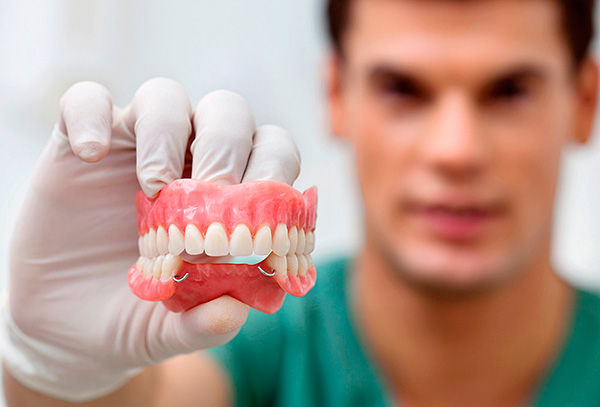
Next you will find out:
- What are removable dentures made of acrylic plastic, and how they look in practice;
- What are generally acrylic dentures and how they can be mounted on the jaw;
- Pros and cons of acrylic prostheses, and why dentists, unlike patients, consider them only as temporary orthopedic constructions;
- How exactly is the manufacture of a removable dental prosthesis made of acrylic plastic, and at what stages the obligatory presence of the patient is required;
- How to properly care for acrylic prostheses so that they serve for a long time and do not harm the oral cavity;
- Is it possible to repair a broken acrylic denture on your own at home and what important details should be taken into account;
- And, finally, how much are removable acrylic prostheses and what factors directly determine their price ...
Despite the increasing criticism by dentist orthopedic practitioners of dentures made of acrylic plastic with each passing year, these orthopedic constructions, despite their shortcomings, are still one of the most common and commonest in Russia.
However, before we talk about the pros and cons of acrylic prostheses, let's first understand - what kind of design is it, what does it look like and how does it actually work in practice.
In simple terms, an acrylic prosthesis is a removable plastic construction that replaces the teeth lost by the patient and, as a result, allows you to fully chew food and have a quite nice smile. The basis of such a prosthesis made from pink plastic (basis) imitates the gum and palate (for the upper jaw) and is adjusted to the jaw of a particular patient individually. In the plastic base, artificial teeth are attached - they are standard, and are taken by a dental technician from special sets of artificial teeth.
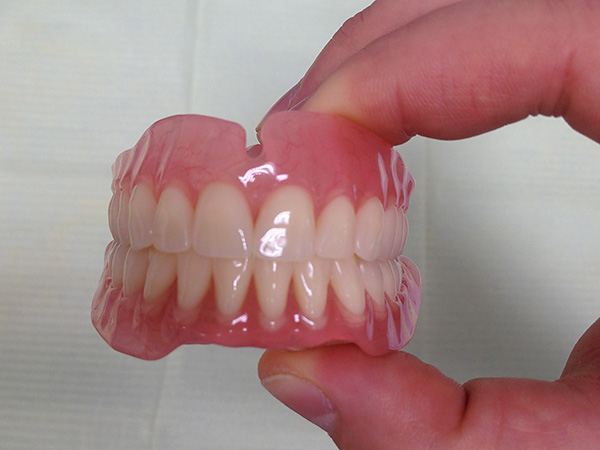
As the name implies, the most important feature of a removable acrylic prosthesis is the ability of the patient at any time to remove the structure, and later, if necessary, it is easy to install it back. In the case of using fixed prostheses, there is no such possibility: for example, it is impossible to remove bridges, or, say, crowns, fixed on supporting teeth with special cements.
On a note
As you understand, the fact that the prosthesis of acrylic plastic is removable is perceived by most people as a minus rather than a plus. Few people enjoy the idea that they will have to use the so-called "false jaws", which, for even an hour, can also move away from the jaw (fall out) at the most inopportune moment.
However, not everything is so bad: some types of prostheses made of acrylic plastic can be fixed with metal hooks (clasps) or special locks for supporting teeth. In some cases, this fixation is obtained so efficiently that without considerable effort (less often - without the help of a dentist) the prosthesis cannot be removed.
For the sake of fairness, it must be said that removable dentures made of acrylic plastic, despite some obsolescence of this prosthetics technology, have far from only negative feedback, but there are also quite a few positive ones, both from the dentists and from the patients.
In general, such constructions exist since the epoch of Soviet dentistry, and although during this time the technique of their manufacture has undergone a number of significant changes, in any case, the main material of the prostheses remains acrylic, which the dentists were up to for a number of reasons just below). As for the negative reviews of patients on the use of acrylic prostheses found on the Internet, it is useful to consider such comments from a certain critical angle: people who use prostheses with pleasure usually rarely write about this on websites. But those who are faced with some kind of problem, as a rule, actively seek to share a bad review, emphasizing the terrible quality of the product itself and the deplorable results of its use.

Feedback:
“My husband has been using an acrylic prosthesis for 3 years, all this time he grumbles. First, the prosthesis rubbed on the gums, okay, they went off, corrected something, it became better. But I still could not get used to it for a long time, I complained that I didn’t feel the taste of food, it interfered with my conversation. And in addition to problems with diction still dry mouth. Then he rarely began to use, said that he felt like a disabled person with him ... "
Oksana, St. Petersburg
But are acrylic prostheses as scary as they are sometimes written in reviews? Or does this kind of prosthetics really be a good choice from both a functional and aesthetic point of view? Let's understand ...
What are acrylic prostheses
So, what is an acrylic prosthesis, we in the most general terms looked at above. However, it must be borne in mind that dentures made of acrylic plastic are of several types - let's talk about them.
Let's start with the so-called full acrylic prostheses - they are made with no teeth in the jaw. Accordingly, there may be a full denture of the upper jaw and a full denture of the lower jaw. In the case when there are no teeth at all in the oral cavity, both are installed at once.
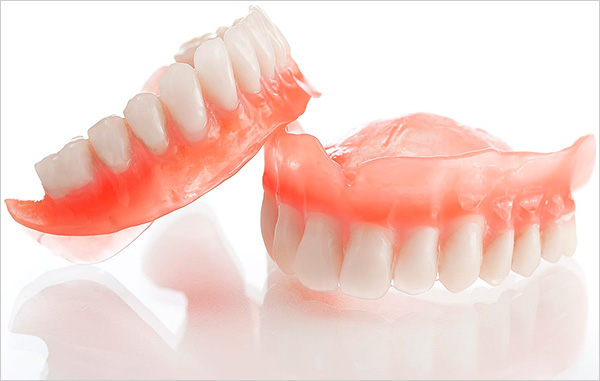
In the upper jaw, the prosthesis is supported by the alveolar process, palate, natural folds and zones of anatomic retention. In the lower jaw there is less opportunity to hold an acrylic prosthesis, since there is no suction option, as in the upper construction, which can stick to the sky. Accordingly, the lower removable acrylic prosthesis is able to hold, primarily due to the natural anatomical structures and adhesion (adhesion) to the gums on the alveolar bone.
It is interesting
For carrying out removable prosthetics in the complete absence of teeth, an orthopedic dentist relies on the condition of the alveolar processes, cords, and the mucous membrane, bridles, etc. Most often, full removable prosthetics are applied when serious atrophy of the alveolar processes occurs. This is mostly about elderly people, people with disabilities, and seriously ill patients who, for financial reasons (most often), are denied orthopedic treatment.
Patients are often pulled until serious health problems appear: disruption of the gastrointestinal tract, the formation of "senile facial expression", jaw extension, problems with the temporomandibular joint, which sometimes leads to speech and hearing disorders. The success of prosthetics in such patients directly depends not only on the tactics of the dentist, but also on the conditions in the oral cavity to hold the prosthesis. This is what determines to a large extent the state of comfort when wearing a construction of acrylic plastic.
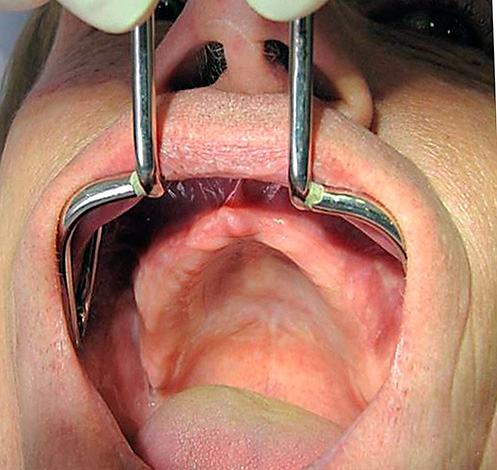
However, partial acrylic prostheses are often used. In the presence of at least a few teeth in the oral cavity, the situation with the convenient fastening of plastic structures is much more favorable than with full edentulous.This is due to the fact that for additional effective retention of a partial acrylic prosthesis, 1 or more teeth are used as a support.
Klammer fixation is one of the most common: a denture clamp (in other words, a hook) covers the teeth selected under the support above the gum edge, which ensures reliable fixation of the structure (see the example in the photo below).
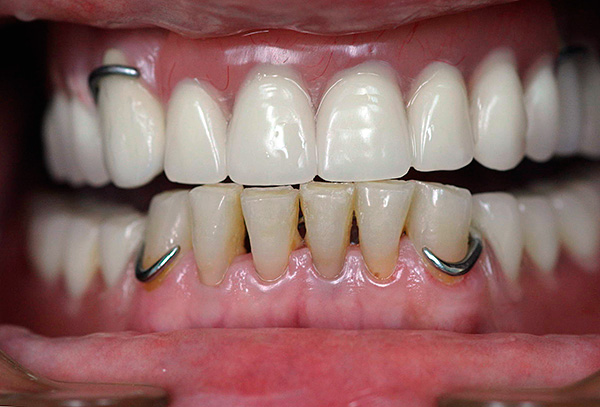
On a note
Plastic prostheses can be conditionally fixed - for example, covering prostheses attached to the prepared tooth roots or prosthetic implants installed in advance. Such designs are functional and look quite aesthetically pleasing, and only a doctor with the help of special tools can remove them.
Fixed covering prostheses are usually made not of acrylic plastic, but of more elastic nylon, and they are also of two types: partial (fixed to the roots) and full (attached to the installed implants in the absence of all teeth).
Separately, it is worth mentioning partial immediat prostheses made of acrylic plastic, which have numerous positive reviews from grateful patients.The fact is that these so-called prosthetic butterflies are an excellent option for temporary prosthetics when you need to remove a tooth (or several teeth at once), but you don’t want to walk with a “hole” in the dentition for a long time. Acrylic plastic is still a common material for the manufacture of prosthetic butterflies.
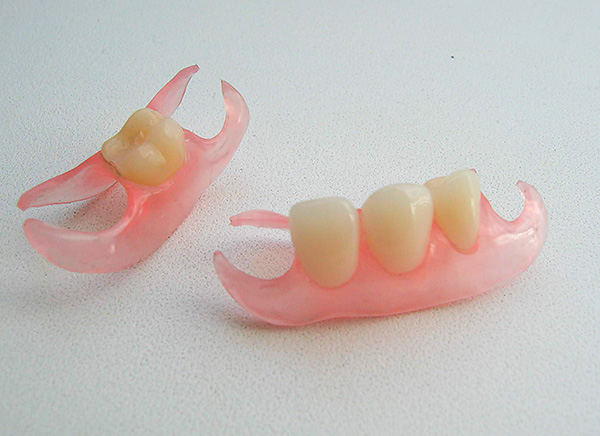
I would also like to note an important point about which many patients think a little: dentists consider all removable prostheses of acrylic plastic as structures for temporary prosthetics. That is, it is assumed that, ideally, the patient will later install, for example, implants that will prevent bone loss (if you wear removable plastic prostheses for a long time, the bone does not receive sufficient chewing load and gradually atrophy - it is possible, for example, to change facial features).
It is clear that not every patient is willing to fork out for the installation of expensive implants. So it turns out that “nothing is so permanent as temporary” ...
The advantages of acrylic dentures
Before highlighting the positive aspects of acrylic prostheses, let's first clarify some details. Today, as a rule, certain advantages and disadvantages of prostheses made of acrylic plastic are opposed to the characteristics of nylon prostheses, which are positioned as more modern. And the key question that many people are interested in in this regard is, in general, the following: what kind of denture is better, acrylic or nylon?
The photo below shows an example of a partial nylon prosthesis in the upper jaw:
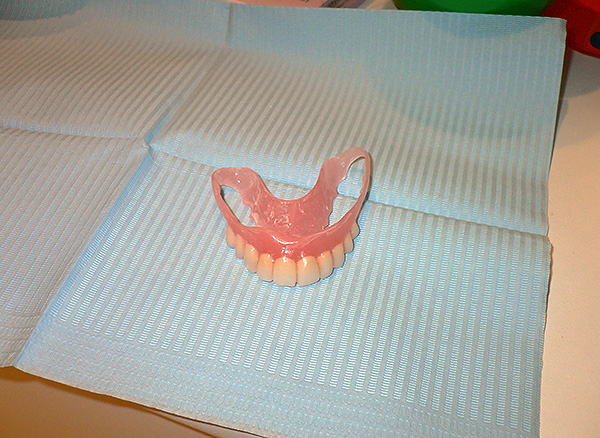
So, from a professional point of view and strictly speaking, it is better that which is not only shown in a particular clinical situation, but also allows to solve a maximum of problems in the future with minimal negative influence. And asking the dentist which denture is better is the same as asking the manager of a car dealership which car is better: one that is cheaper, or one that is more expensive. The financial component in the selection and in fact, and in another case should be taken into account, if not in the first, then not least.
However, often not quite conscientious orthopedic physicians speculate on the advantages of expensive constructions, especially sticking out the disadvantages of cheaper acrylic prostheses. More precisely, they pull out of context a negative property occurring in a given construction, warning the patient of a danger that does not exist for him. As a result, the methods and materials tested over the years begin to give way under the onslaught of “crammed” patients and products that are more convenient for the doctor’s wallet.
Meanwhile, the simple truth is quite obvious: there is no universal ideal prosthetic dentistry. Some here may object: as it is - I have already been made such a prosthesis, and I use it without a hitch. In fact, every successful case is the result of a correct diagnosis and an individually chosen orthopedic treatment plan. Simply put, one grandmother would have enough of an ordinary acrylic prosthesis for a comfortable life and a wallet, while another grandfather would have the most perfect nylon prosthesis not to be the court, but his neighbor in the cottage would fit perfectly.
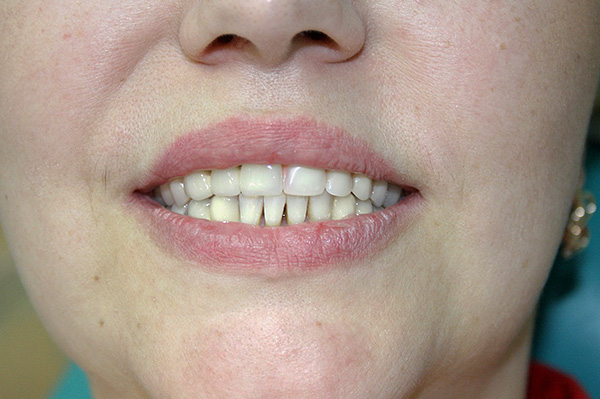
We now turn to the specifics.
The main advantages of acrylic dentures:
- Relatively low cost. For many people, the low cost of a prosthesis may be a reason to doubt the quality of the design, but in the hands of a skilled doctor an acrylic prosthesis can solve its tasks fully, both in aesthetic and functional terms.As a result, it is possible to acquire artificial teeth for little money, and in some cases even free of charge (thanks to the CHI program, retirees and certain social categories of people can, in turn, receive partial or full acrylic prostheses for free);
- Ease of use. Properly made acrylic prosthesis is easy to put on and take off, and it is not much more difficult to care for it than for your own teeth;
- Ease and durability of the material;
- The possibility of manufacturing for one visit;
- Acceptable, or even excellent aesthetic characteristics in the case of competent selection of the color of artificial teeth;
- The possibility of repairing after a breakdown;
- Adequate load distribution during chewing.
Feedback
“Now even young people go with artificial limbs and normally. So I decided, I will put the prosthesis on the lower jaw. What will be will be, I have already prepared my mouth, there will be crowns in the front, and there will be an acrylic prosthesis in the back. My girlfriend has been with such a prosthesis for 2 years already, she likes everything, says that, like her own teeth, she does not even notice that she doesn’t take off for the night. And I have no other options, so it remains to hope that everything will be fine ... "
Galina, Moscow
What you should know about the shortcomings of acrylic prostheses in advance
Despite the seeming simplicity of making a removable acrylic prosthesis (to mold the plastic base and fix artificial teeth in it), the orthopedist and the dental technician are not always able to take into account the individual characteristics of the patient's oral cavity.

That is why it is so often heard in reviews that the acrylic prosthesis turned out to be inconvenient, the teeth are “horse-like”, that the prosthesis rubs the gums, falls out, diction suffers, a gag reflex occurs, etc. Many people mistakenly consider this a disadvantage of acrylic (acrylic plastic), but in reality one of two problems most often affects: either the lack of professionalism of the specialist, or the orthopedic tandem and the dental technician have become obsolete (yes, it happens).
To this may still be added the imperfection of diagnostic methods and the lack of the necessary equipment. Generally, in removable prosthetics, regardless of its type, every little thing is important: if the doctor will count the features of the jaw and its anatomical structures by eye, then even after numerous corrections, the patient will simply put the prosthesis on the shelf.
What to consider the real disadvantages of acrylic plastic prostheses?
- Increased risk of allergy to acrylic or functional additives present in plastics (dyes, antioxidants, plasticizers). Allergy, manifested, for example, in the form of prosthetic stomatitis, is more often caused by trace amounts of methyl methacrylate - methacrylic acid methyl ester contained in dental prostheses. Modern technology can overcome this problem. For example, for many years, there has been a technology to protect the mucous membranes of the oral cavity from plastic monomers using insulating spacers, the glass transition of a prosthetic surface and other types of surface treatment;
- The porous structure of plastic, as a possible breeding ground for bacteria. Special studies have shown that plastics from acrylic can gradually "absorb" organic matter from food (including dyes), as a result of which bacterial plaque forms on the plastic surfaces of the prosthesis. However, if you follow the rules of hygiene and care for the prosthesis, this process can be minimized (in the end, bacterial plaque is formed on the person’s own teeth and on the surface of the tongue).
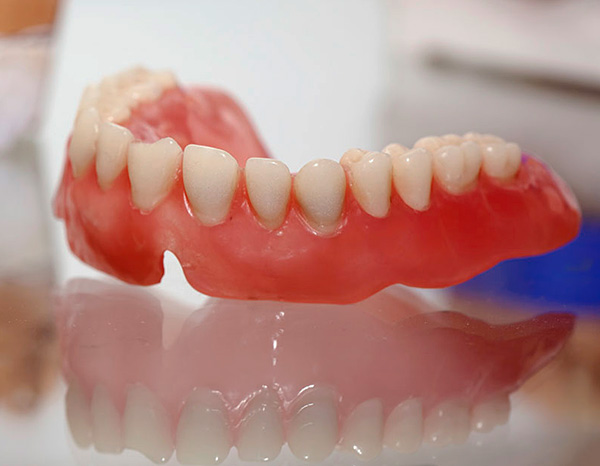
The remaining shortcomings (complexity of adaptation, possible disturbance of taste and diction, low level of fixation, possible injury to the gums, lack of aesthetics of the clasps, etc.) can be called conditional, as they are mostly the result of errors of orthopedic treatment. The fact is that the lion's share of such deficiencies in the case of a low level of skill of the doctor can also manifest itself in other types of prosthetics, even on implants.
The disadvantage of acrylic prostheses is also the increased brittleness of acrylic plastic, as a result of which the structure can break, for example, when it falls or even simply when chewing solid food.
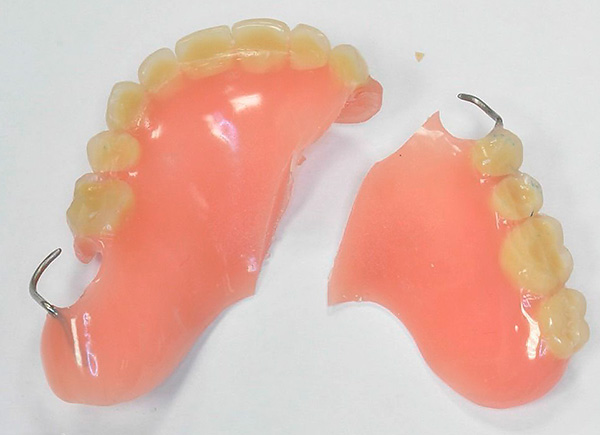
As the prosthetic bed atrophies, the risk of breakage of the acrylic prosthesis increases. And even if the acrylic prosthesis can be repaired with one's own hands (for example, craftsmen like to glue with epoxy or super glue), then with a high probability at the next load it will break again, since its basis is already poorly matched to the changed bed base. As soon as the relief of the bed has changed, you need to make a new acrylic prosthesis, and not to engage in its regular self-repair.
Feedback
“I had a removable denture made of acrylic six months ago, but I couldn’t use it regularly. All because of the vomiting reflex raised to horror. I was unable to communicate normally, and so I could not with him. Actually, I chose this prosthesis myself, as there was simply not enough money for something else, and the doctor immediately warned me that it would be difficult to get used to it at first. Even when the cast was taken from above, I almost vomited. I thought that I was trite with a blunt prosthesis, his doctor initially advised. Now I understand that the clasp dentures do not really cover the sky, so people have almost no urge to vomit ... "
Olga, Samara
How is the manufacture of dentures from acrylic plastic
The principle of manufacturing a removable prosthesis of acrylic plastic from the point of view of the patient is quite simple, and the whole process, in fact, consists of only two stages: clinical and laboratory. Clinical is performed in the office of an orthopedic dentist, and laboratory - in a dental laboratory.
Consider the technology of manufacturing prostheses from acrylic in order:
- The first clinical stage includes the preparation or processing ("turning") of the abutment teeth (if they exist) with the subsequent removal of impressions from the patient's jaws. Almost always crowns will be made on the abutment teeth in order to prevent the negative effects of contact with the teeth. The duration of this clinical stage is from 30 minutes to 2-3 hours, depending on the complexity of the work;

- At the first laboratory stage, the dental technician casts the plaster models using the impressions obtained - this is, in fact, the patient's jaw, but only from plaster. Bite wax rolls form along them;
- At the second clinical stage, the patient bites these rollers to determine the height of the bite and its features. It usually takes about 15-30 minutes;
- At the second laboratory stage, the technician creates a wax model of future jaws with artificial teeth installed on it;
- At the third clinical stage, an orthopedist tries on a wax construction in the patient's mouth;
- At the third (last) laboratory stage, an acrylic prosthesis is made, as a rule, it is whole-cast. Then the structure is polished and polished;
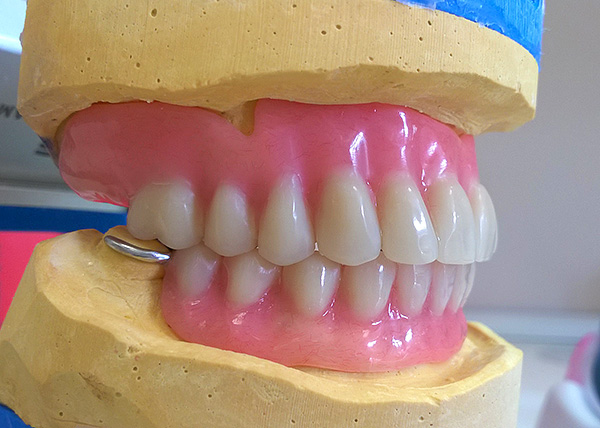
- After the transfer of the finished products from the laboratory, the orthopedic dentist gives dentures to the patient: he sets and adjusts them according to the situation. In this case, the shade of artificial teeth corresponds to the Vita color scale agreed with the patient at the clinical stages of treatment (color chart).
Basic rules for the care of acrylic prostheses
Most people today are well aware of how to properly care for their teeth: rinse every time after eating and brush in the morning and before going to bed with a toothpaste brush. Despite the fact that acrylic plastic is an artificial material and, it would seem, bacteria are too tough, in fact, you need to care for an acrylic prosthesis just as carefully as for your native teeth. All principles of care remain the same: rinse your mouth after eating and brush your denture with a toothbrush and toothpaste.
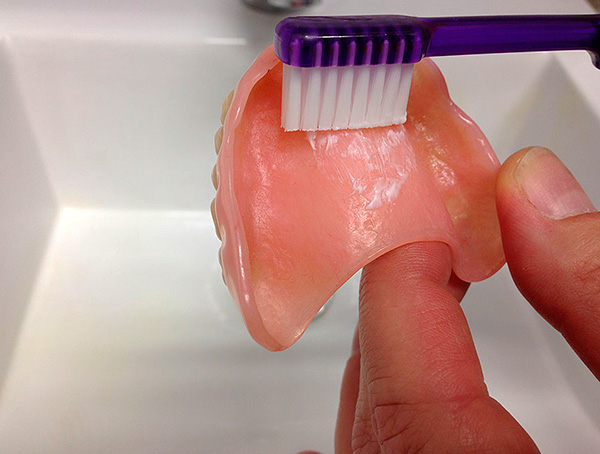
On a note
Just do not use whitening toothpaste - such pastes are characterized by increased abrasiveness, but you do not want to quickly grind off plastic?
If it is impossible to clean the prosthesis by rinsing the mouth, you can rinse the structure under running water after a meal. In addition, there are special solutions for additional hygiene of the prosthesis and maintaining it in good condition.

Do not forget that any problems associated with discomfort after receiving the prosthesis, require monitoring by the doctor. It doesn't matter when they manifest: the next day or a few months later. Mandatory recommendation is to visit the orthopedist 1 time in 6 months for monitoring and possible “amendment” of the basis or retention elements of the prosthesis.
Feedback
“I've been wearing an acrylic prosthesis for 3 years now and I can say that this is convenient and the price is affordable. And if I put implants, as the doctor counted, then I would have to sell the car, or at least a kidney. Removed easily, no problems being cleaned. Brush it with a regular toothbrush. The prosthesis does not rub the gums and sits in the mouth like a glove. In short, while I have no complaints. Hopefully, the prosthesis will last a long time. ”
Ivan, Yekaterinburg
Is it possible to repair the denture yourself?
If the acrylic denture is accidentally dropped into the sink or on the floor during hygienic procedures, or it is excessive to load its individual zones while chewing food, a crack may form in the baseline or even a fracture of the structure may occur.
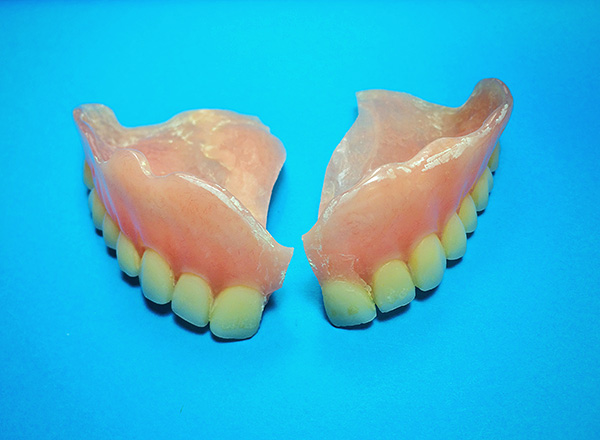

Repairing a removable acrylic denture with your own hands is not possible in all cases. For example, if a clammer (hook) of a structure broke, then a person without special skills is unlikely to be able to replace it.
The main mistake of especially “advanced” people is an attempt to glue the fragments of the prosthesis with the first adhesives that came to hand: epoxy glue, “Moment”, and sometimes even try to use PVA. Often, this independent initiative leads to undesirable consequences due to the toxic effect of substances contained in the glue, which, after prolonged contact with the oral mucosa, can cause dermatitis and eczema (especially with an incorrect ratio of hardener and epoxy resin).
Here are some nuances that are useful to consider if you suddenly decide to repair the denture yourself:
- When using PVA, the glue line can become soft under the action of moisture - accordingly, the glued halves will quickly disperse again;
- Rubber adhesives do not even try to glue the acrylic denture. The adhesive joint must not be elastic, but hard (in the case of nylon prostheses, the situation may be exactly the opposite);
- When using an excess amount of hardener in relation to the epoxy resin there is a risk of severe irritation of the gums with alkaline amines that are part of the hardener;
- In some cases, superglue (cyanoacrylate) may be suitable for temporary repair of an acrylic prosthesis - for example, if you signed up for a repair to a dental technician, but you need to wait a few more days, but you don’t want to go without teeth. Well, in this case, with proper and accurate work, repairing the denture with super glue may be more promising and safer than trying to use other types of adhesives (of course, it is important to follow the instructions for using super glue). However, it should be borne in mind that in this case, the adhesive joint will gradually lose strength due to the constant action of moisture.

On a note
Some craftsmen sometimes try to also solder a broken acrylic denture at home. As a rule, such attempts end in failure, even if polymethyl methacrylate is used as a kind of hot melt adhesive.
With regard to the correction of the prosthesis, for example, in relation to too tight or, conversely, free clasps - this is also better to contact a dental technician.If, however, decide at your own risk to repair the denture at home - in this case, you can use the round pliers. It should be done as carefully as possible with the constant fitting of the prosthesis, so as not to accidentally break off the hook.
The same applies to the correction of the basis of the prosthesis, if it rubs the mucous. If you are not sure that you will be able to polish it with nail files or sandpaper, it is better not to start at all. The risk of permanently spoiling the prosthesis when repairing it with your own hands is very high, so for the maximum result it is preferable to correct the removable structure from a dentist.
A few words about the cost of acrylic prostheses
The cost of an acrylic prosthesis largely depends on the materials used for its manufacture, as well as on the length of the dentition defect.
For example, at the request of the client, acrylic plastics from Russian, Czech and even Japanese manufacturers can be used to manufacture the basis. Accordingly, the price of the finished product can vary significantly, sometimes differing at times.

The price of an acrylic prosthesis is also formed according to the method of fixing it to the supporting teeth. Acrylic dentures with a small number of artificial teeth can be relatively inexpensive, but it is important to remember that in addition to removable structures, crowns for supporting teeth can also be made, which is charged separately for each unit of the crown.
In general, the cost of removable acrylic prostheses for the entire jaw (upper or lower) usually ranges from 5 thousand rubles to 15-20 thousand, depending on the level of the clinic, the quality of plastics for the bases, the purchase price of dental headsets and some other factors.
Useful video about corns in the oral cavity caused by acrylic prosthesis
How to fully live with a removable denture and care for him

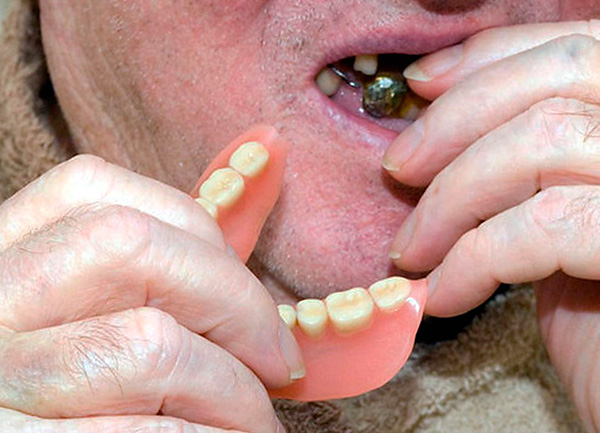
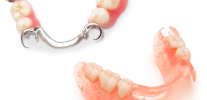
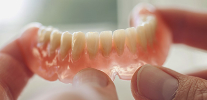
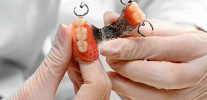
Very sensible and informative article.